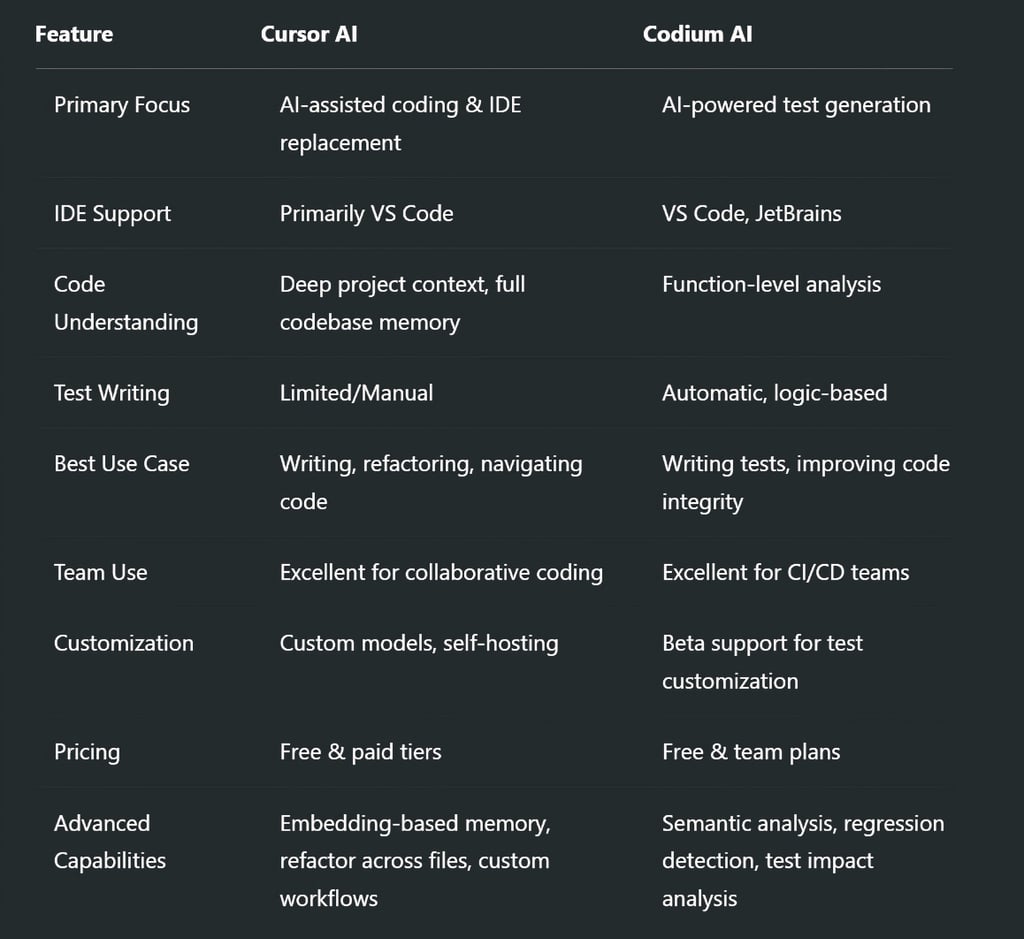
Cursor AI vs Codium AI (2025): Which AI Coding Assistant Reigns Supreme?
Discover the key differences between Cursor AI and Codium AI in 2025. Explore their features, technical capabilities, ideal use cases, and which AI coding assistant suits your development workflow best.
AI/FUTUREEDITOR/TOOLSAI ART TOOLS
Sachin K Chaurasiya
4/13/20254 min read


In the fast-paced world of software development, AI coding assistants are becoming essential tools for developers. Among the most talked-about names in 2025 are Cursor AI and Codium AI. Both aim to boost developer productivity, reduce bugs, and offer intelligent code suggestions. But which one is better suited for your workflow?
Let’s break down the battle between Cursor AI vs. Codium AI, comparing their features, use cases, pros, cons, and ideal users—so you can make the right decision for your coding needs.
What is Cursor AI?
Cursor AI is an AI-powered coding environment that blends the power of GPT-based models directly into a developer’s IDE (primarily VS Code). It’s not just a code completion tool—it transforms your entire coding workflow by allowing you to ask questions, generate whole functions, and even refactor legacy code.
Key Features
Chat-like interface within your IDE: Seamlessly ask questions or describe tasks.
Context-aware coding: Cursor understands the full project, not just the current file.
Smart navigation: Jump to definitions, generate docstrings, and refactor intelligently.
Git integration: Review diffs and get suggestions based on code changes.
Custom fine-tuning: Use private models for enterprise-level security.
Multi-modal interaction: Accepts natural language, code snippets, and diffs.
Custom workflows: Trigger predefined prompts for repetitive tasks like API scaffolding or Dockerfile generation.
Embedding-based memory: Uses token-efficient embeddings to maintain awareness of large codebases.
Advanced Technical Capabilities
Fine-tuning support on private LLMs such as OpenAI GPT-4, Anthropic Claude, or Mistral models.
Codebase vector indexing for fast semantic retrieval.
Supports advanced refactoring with in-line multi-file diff visualization.
Memory-aware prompts to analyze changes across thousands of lines of code.
Support for JSON-RPC and RESTful API integration for DevOps automation.
Ideal For
Developers are looking for a fully integrated AI development experience.
Teams working on large codebases and complex applications.
Users who prefer natural language interaction in coding.
Enterprises seeking secure, customizable AI workflows within their stack.
Pros
Integrated chat and prompt-based development
Smart project-wide awareness
Flexible and developer-centric
Custom model support and security-conscious setup
Cons
Learning curve for prompt engineering
Not specialized in testing
May require strong hardware for self-hosted options


What is Codium AI?
Codium AI focuses on test generation and code integrity. Its flagship tool, “TestGPT,” automatically writes meaningful tests (unit, integration, etc.) by analyzing the logic and behavior of your functions. While Codium has added code suggestions and explanations, its core strength lies in AI-powered test coverage and ensuring code reliability.
Key Features
Auto-generated unit tests: Cover edge cases and logic branches.
Support for multiple languages: Python, JavaScript, TypeScript, Java, and more.
Code explanation: Understand what code is doing before you modify it.
CI/CD integration: Add tests directly into pipelines.
IDE Extensions: Works inside VS Code and JetBrains IDEs.
Static analysis: Identifies function complexity and unreachable branches.
Parametric test generation: varies input combinations to find edge-case vulnerabilities.
Test impact analysis: Identifies parts of the codebase affected by recent commits.
Advanced Technical Capabilities
Semantic analysis for understanding control flow and dependency trees.
Dynamic mocking: Automatically mocks external APIs and dependencies.
Regression detection: Suggests test cases that might reveal unintended side effects.
Integrates with GitHub Actions, GitLab CI/CD, Jenkins, and CircleCI.
Real-time telemetry: Measures test execution time, coverage efficiency, and flakiness.
Ideal For
QA engineers and test-driven developers.
Backend developers deal with logic-heavy applications.
Teams are aiming for higher test coverage and reliability.
Organizations practicing continuous integration and delivery.
Pros
Best-in-class test generation
Supports multiple languages
Lightweight and easy to integrate
Improves test coverage with minimal human input
Cons
Limited code generation compared to Cursor
May not cover complex test scenarios without review
Focuses narrowly on testing, not full development lifecycle


When to Choose Which?
Choose Cursor AI if
You want a code-first environment enhanced by AI.
You're working on a large-scale project and want intelligent code generation and editing.
You prefer a "co-pilot" experience where AI helps write and refactor code hands-on.
You need support for custom LLM deployment and security compliance.
Choose Codium AI if
You're focused on writing tests or improving code quality.
Your team emphasizes TDD (Test-Driven Development).
You want to catch bugs early and increase confidence in your releases.
You are optimizing for maintainability and automated QA at scale.
How Do They Use AI?
Both tools use large language models (LLMs) under the hood—likely variants of OpenAI’s GPT or similar models—but they use them differently:
Cursor AI treats AI like a coding companion that thinks in terms of context, user prompts, and whole-project interactions. Its vector memory and token optimization help it scale across massive monorepos.
Codium AI uses AI as a test engineer—analytically walking through your code logic and predicting potential breakpoints or test cases. It leverages symbolic execution and AST parsing to build comprehensive tests.
Cursor AI or Codium AI?
If you're looking for an AI development partner that assists with coding, debugging, and navigating complex projects, go with Cursor AI.
If you need a dedicated AI test engineer to boost test coverage and code reliability, Codium AI is your go-to.
TL;DR:
Cursor AI = “Write better code faster.”
Codium AI = “Make your code safer and more testable.”
Bonus: Can You Use Both?
Absolutely! Many developers use Cursor AI for day-to-day coding and Codium AI for generating and managing tests. Together, they form a powerful toolkit to build, refactor, and secure your codebase using AI.
If you're still torn, consider your primary workflow needs: are you writing a lot of new features or ensuring that existing ones are solid and tested? Your answer will point you in the right direction.
Subscribe To Our Newsletter
All © Copyright reserved by Accessible-Learning Hub
| Terms & Conditions
Knowledge is power. Learn with Us. 📚


